What if a UFO Landed in a Bar?Alien Island by T. L. Sherred
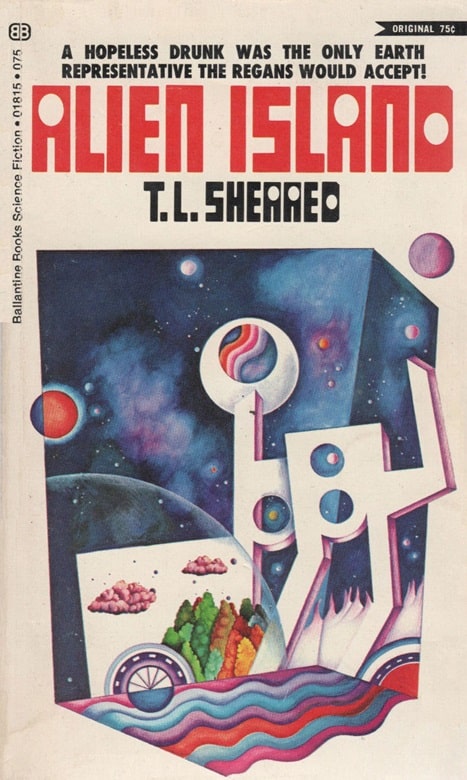 |
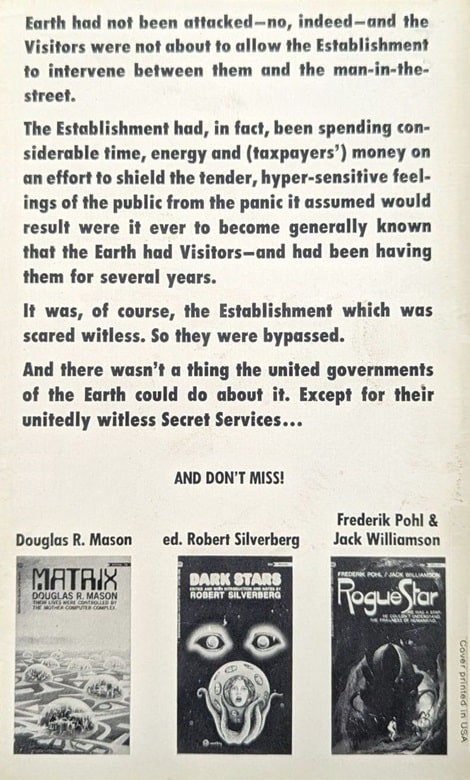 |
Alien Island (Ballantine Books, January 1970). Cover by Carol Inouye.
Here’s my latest look at a little-remembered 1970s novel, T. L. Sherred’s Alien Island, which appeared in the very first month of the 1970s. These days T. L. Sherred is remembered for a single story, his SF Hall of Fame novella “E For Effort.” It’s a great story, and a deeply cynical one, so much so that there are those who claim that it was not chosen by John W. Campbell for Astounding, but by someone else in Campbell’s absence. (I’m skeptical myself — Campbell was a VERY hands-on editor, and he also chose to reprint “E for Effort” in The Astounding Science Fiction Anthology. And he was definitely known to publish good stories that seemed to run counter to his own ideology.)
Sherred published three other stories in the early 1950s: “Cure, Guaranteed,” “Eye for Iniquity,” and “Cue for Quiet,” and then fell silent (save for a story, “See for Yourself,” in Escapade in 1961, that I have not seen) until the 1970s. The novel at hand was published in 1970, and in 1972 Harlan Ellison included “Bounty” in Again, Dangerous Visions; and “Not Bach” appeared in the very well-regarded fanzine Outworlds.
[Click the images for your eyes to land on larger versions.]
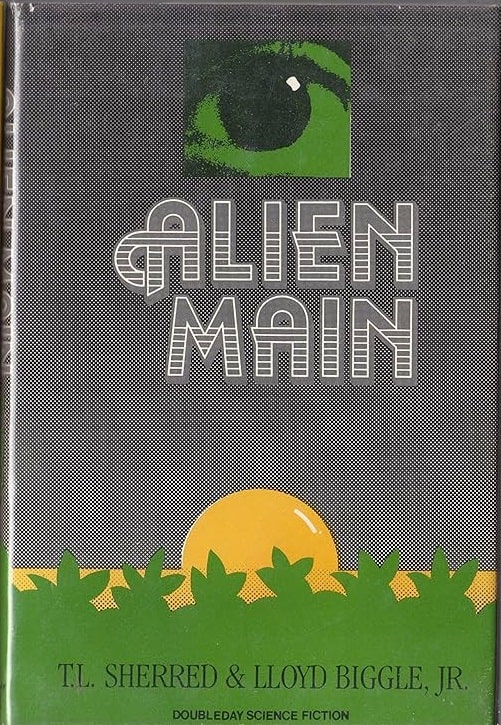 |
 |
Alien Main by T.L. Sherred and Lloyd Biggle, Jr. (Doubleday, July 1985,
and Wildside Press, April 2020). Covers by Michael Pilla, unknown.
A sequel to Alien Island, Alien Main, which Sherred had left unfinished at his death in 1985, was completed by Lloyd Biggle, Jr. and published that same year. As Sherred had had a stroke in 1971, and Harlan Ellison’s introduction to “Bounty” suggested that his writing days were over, it seems likely that Biggle (who, like Sherred, lived in the Detroit area) did most of the writing on that novel. (Biggle was a Professor at Eastern Michigan University (where my mother, also from Detroit, got her degree.))
Thomas L. Sherred (1915-1985) was an autoworker, who began on the factory floor but ended up in the technical writing department. His politics were clearly on the left, and he often wrote about working men. And his stories — including Alien Island — had a distinctly cynical edge to them. He never reached the heights of “E for Effort” again, but everything I’ve read from him (except perhaps “Bounty”) was at least intermittently, and often entirely, enjoyable.
Inside cover of Alien Island
Alien Island is narrated by Dana Iverson, who works for the CIA. We learn quickly that Iverson’s department is tasked with keeping track of UFO sightings and tamping down public interest in them. As the novel opens, Iverson is sent to Detroit to work at a bar at which a spaceship actually landed — and a local machinist, and notorious drunk, wandered in.
It’s soon clear that the jig is up — this spaceship won’t be ignorable. The drunk, one Ken Jordan, returns in the spaceship shortly, and the aliens reveal themselves, specifically in the person of the Captain, an astonishingly beautiful woman named Lee Lukkari. Ken Jordan reveals that he has learned the alien language by having melded minds with Lee Lukkari. And Lee Lukkari, after describing the alien mission — they are representatives of an interplanetary society called the Regan Group — states that Ken Jordan will be the Regan Group’s ambassador to Earth.
Dana Iverson is assigned by the CIA to infiltrate Ken Jordan’s organization, and quickly becomes a trusted assistant. Ken Jordan (the Regan Group does not use honorifics like “Mr.”) sets up to buy products of Earth societies — such as Irish whiskey — that might appeal to the members of the Regan Group. And he arranges to buy a Canadian island in the Detroit River.
He and Iverson and other employees — eventually a bunch of high school kids — settle the island, and Regan Group tech builds a force field around it. In the process, Iverson’s loyalties are tested — and fractured. Same with the high school kids. Part of the problem is that many countries — and the US. in particular — resent some of the choices Jordan makes — no US products are bought, for example.
 |
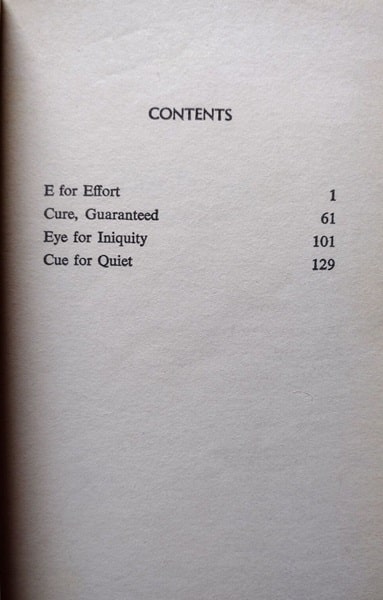 |
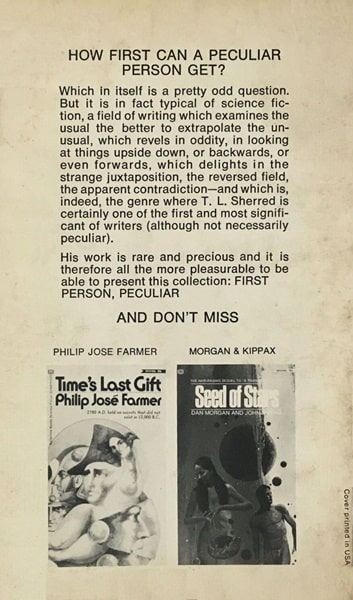 |
First Person, Peculiar by T.L. Sherred (Ballantine Books, January 1972). Cover by John Holmes
I won’t reveal the ending. It’s a curious novel, and, really, rather a mess. The beginning is terribly slow. And the tone modulates oddly. At the open, and for much of the book, really, it seems aimed at mild, almost whimsical (to use Algis Budrys’ word) satire; but by the end the vision entirely curdles, in a way that didn’t seem earned to me. Sherred plays a mild trick on the reader involving Dana Iverson’s character — which actually kind of works. But a lot of the action just doesn’t convince; and Sherred’s despair about human nature overtakes the book by the end. The sexual politics are not offensive, really, but, well, pretty darned old-fashioned.
There is a coda which looks forward to the future — a hint at what must happen in Alien Main, suggesting that Sherred had ideas for the sequel, which I assume his stroke prevented him from finishing, hence Biggle’s involvement. I have that book, and I’ll get to it eventually.
But I have to say I think readers do best to read the four early Sherred stories (collected in 1972 in First Person Peculiar.) The later works I’ve read, Alien Island and “Bounty,” are simply not on a par with even the lesser ’50s stories.
Rich Horton’s last article for us was a review of Three Thousand Years of Longing, and the source material, “The Djinn in the Nightingale’s Eye” by A. S. Byatt. His website is Strange at Ecbatan. Rich has written over 200 articles for Black Gate, see them all here.
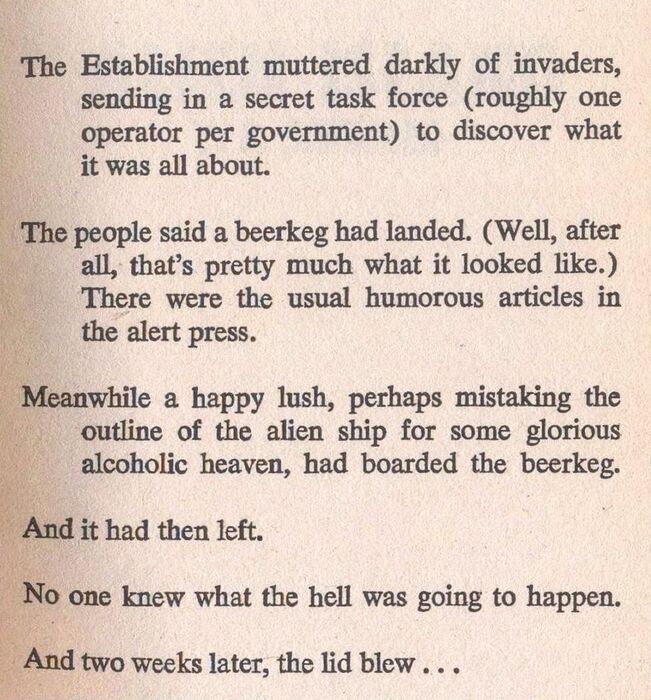
Those were great days–loved the various Ballantine SF that was coming out during the early ’70s, prior to the conversion to Del Rey. Many underrated titles…
Lou,
You have a good memory! Even I didn’t remember this one.
Any other underrated titles you’d like to name drop?